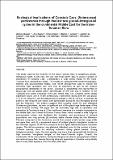Por favor, use este identificador para citar o enlazar a este item:
http://hdl.handle.net/10261/49477COMPARTIR / EXPORTAR:
 SHARE
BASE SHARE
BASE
|
|
| Visualizar otros formatos: MARC | Dublin Core | RDF | ORE | MODS | METS | DIDL | DATACITE | |

| Título: | Ecological implications of Cousinia Cass. (Asteraceae) persistence through the last two glacial–interglacial cycles in the continental Middle East for the Irano-Turanian flora |
Autor: | Djamali, Morteza; Baumel, Alex; Brewer, Simon; Jackson, Stephen T.; Kadereit, Joachim W.; López-Vinyallonga, Sara CSIC; Mehregan, Iraj; Shabanian, Esmaeil; Simakova, Aleksandra | Palabras clave: | Quaternary glaciations Allopatric speciation topographical heterogeneity interglacial refugia tectonic history SW Asia |
Fecha de publicación: | 15-feb-2012 | Editor: | Elsevier | Citación: | Review of Palaeobotany and Palynology 172: 10-20 (2012) | Resumen: | [EN] This study explores the response of the Irano-Turanian flora to Quaternary glacial–interglacial cycles in SW Asia. We use new fossil pollen data to assess variation in abundance of Cousinia Cass. (Compositae), a large genus typical for the Irano-Turanian flora, during these cycles. The results are compared with modern topography, tectonic and palaeoclimatic history, and recent phylogenetic data to explain the extremely high speciation rate and level of endemism as well as the modern geographical distribution of the genus. Cousinia is consistently well-represented in glacial-age and late-glacial pollen assemblages of NW Iran and E Anatolia. In the ~ 200,000-year pollen sequence from Lake Urmia, NW Iran, Cousinia pollen shows significant values and is nearly continuously represented during both the last glacial (~ 70 ka to Holocene) and penultimate glacial periods (~ 190 to 130 ka). In contrast, its pollen is less frequent and occurs only sporadically during the last interglacial period and the Holocene. This pattern suggests that Cousinia could not only withstand Quaternary glaciations, but was a significant part of the glacial-age landscapes of the Irano-Turanian territory. We argue that the extremely high rate of speciation and endemism of Cousinia is due to (i) the continuous presence of a complex topography in the Middle East and Central Asia since Tertiary times, which created a wide range of environmental niches and facilitated the formation and persistence of isolated populations over long periods, (ii) relatively stable climate during the late Miocene–Pliocene compared to the Quaternary period that caused small species range shifts and gene flow, and (iii) a dampened impact of multiple glacial–interglacial cycles on the mountain regions of SW Asia compared to the higher latitude European mountain ranges. This left an extensive, non-glaciated altitudinal zone for the survival of Irano-Turanian species, thereby reducing extinction during glacial periods. During interglacial periods, many Cousinia species may have been geographically isolated in high mountain “interglacial refugia” of the Irano-Turanian region. Overall, the combination of the above factors during the Neogene resulted in geographical isolation and reduced gene flow, thereby fostering allopatric speciation in Cousinia and probably also in many other speciose Irano-Turanian plant taxa. | Descripción: | 10p. gráficas | Versión del editor: | http://dx.doi.org/10.1016/j.revpalbo.2012.01.005 | URI: | http://hdl.handle.net/10261/49477 | DOI: | 10.1016/j.revpalbo.2012.01.005 | ISSN: | 0034-6667 |
| Aparece en las colecciones: | (IBB) Artículos |
Ficheros en este ítem:
| Fichero | Descripción | Tamaño | Formato | |
|---|---|---|---|---|
| ecological_implications.pdf | 1,03 MB | Adobe PDF |  Visualizar/Abrir |
CORE Recommender
Page view(s)
343
checked on 23-abr-2024
Download(s)
540
checked on 23-abr-2024
Google ScholarTM
Check
Altmetric
Altmetric
NOTA: Los ítems de Digital.CSIC están protegidos por copyright, con todos los derechos reservados, a menos que se indique lo contrario.
